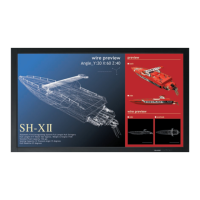PN-465U OUTLINE OF THE PRODUCT, NOMENCLATURE AND FUNCTION
1 – 5
■ Dual screen display
You can display the screens of the PC input signal and AV input signal
simultaneously.
Set this function with “PIP MODES” in the PIP/PbyP menu.
• The currently selected input signal is displayed on the main screen.
• You cannot simultaneously display the screens of signals of the same
type, such as two types of PC input signals or two types of AV input
signals.
Note:
• You might infringe on a copyright of the author which is protected
by copyright law when you display the images of the computer
screen and television/VCR simultaneously for profit-making or to
show the image to the public.
• The screen size for dual-screen display is the same as the screen
size for single-screen display. The DotbyDot screen is displayed in
NORMAL size except when it is set as the PIP main screen.
• When dual-screen display is selected, the SCREEN MOTION func-
tion is disabled.
• When dual-screen display is selected, the screen cannot be
enlarged.
• When dual-screen display is selected, the following adjustments of
ADVANCED are invalid and adjusting is disabled.
3D-NR, MPEG-NR and 3D-Y/C
■ Enlarge
You can align 4, 9, 16, or 25 monitors and integrate them into a single
large screen to display.
Enlarged views of separated images are displayed in each monitor.
In horizontal orientation
In vertical orientation
Note:
• AV input signals cannot be used for the Enlarge function.
• To integrate 9 or more monitors using PC1 signals, a splitter for the
video signal (commercially available) is required.
• When connected in PC2/PC3, a splitter for the video signal (com-
mercially available) is required.
• When Enlarge is used, the SCREEN MOTION function is disabled.
■ Switching the screen size
Even when the screen size is changed, the display may remain the
same depending on the input signal.
PIP : A sub screen is displayed inside a main screen.
PbyP : A main screen and a sub screen are displayed in a line.
PbyP2 : Displays a main screen which measures 1280 pixels in the
longest direction and a sub screen in a line.
PIP PbyP PbyP2
Main screen
Main screen
Main
screen
Sub
screen
Sub
screen
Sub
screen
1
3
0
2
012
456
8
9
10
3
7
11
12 13 14 15
012
567
10
11 12
3
8
13
15 16 17 18
20 21 22 23
4
9
14
19
24
012
345
678
1
3
0
2
012
456
8
910
3
7
11
12 13 14 15
012
567
10
11 12
3
8
13
15 16 17 18
20 21 22 23
4
9
14
19
24
012
345
678
Original
image
4 monitors
9 monitors
16 monitors 25 monitors
PC input AV input
WIDE Displays image so it fills the
entire screen.
An image with a 4:3 aspect
ratio is stretched to fill the
entire screen.
ZOOM 1 An image with a 4:3 aspect ratio is enlarged to fill the
entire screen without changing the aspect ratio. The
edges of the image may be cut off.
ZOOM 2 Use this size if ZOOM 1 cuts off the subtitles.
NORMAL Displays image so it fills the
screen without changing the
aspect ratio of the input sig-
nals.
Displays the entire image
of the aspect ratio of 4:3
without changing the
aspect ratio.
DotbyDot Displays the dots of the sig-
nals input from the conne-
cted PC as the correspond-
ing dots on the screen.
*
Displays the dots of the
input signals as the corre-
sponding dots on the
screen.
1
3
02
0
1
2
4
5
6
8
9
10
3
7
11
12
13
14
15
0
1
2
5
6
7
10
11
12
3813
15
16
17
18
20
21
22
23
4
9
141924
0
1
2
3
4
5
6
7
8
1
3
02
0
1
2
4
5
6
8
9
10
3
711
12
13
14
15
0
1
2
5
6
7
10
11
12
3813
15
16
17
18
20
21
22
23
4
9141924
0
1
2
3
4
5
6
7
8
Original
image
4 monitors
9 monitors
16 monitors 25 monitors

